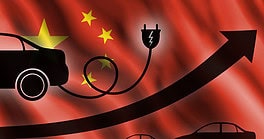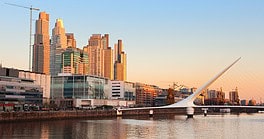LATIN AMERICA
Building On Solid Foundations
Few financial systems around the world have recovered from the 2008 global economic downturn as quickly as Latin America’s, with lessons learned from previous crises—both foreign and domestic—serving them well. Having financed their long-term growth by tapping funding sources at home—and with the region’s governments having overhauled their respective regulatory and supervisory structures—Latin American banks were well capitalized in 2010 and ready to take advantage of the region’s strong economic rebound. Latin America experienced an economic expansion of 6% last year, according to the United Nations Economic Commission for Latin America and the Caribbean. The uptick fortified consumer demand and pushed companies to seek financing to fund expansion plans. There was a strong focus on providing support to small and medium-size enterprises (SMEs). Although not all countries experienced the same level or pace of recovery, Brazil, the region’s largest market, posted 7.5% GDP growth in 2010. This translated into big wins for Brazilian banks, some of which saw net income soar by more than 20% year-on-year. Foreign banks also continued to explore opportunities in the region. Among the challenges remaining last year for private sector banks was the increased role that state-owned banks assumed during the recent crisis, particularly in Brazil, which unleashed a battle for market share. Remittances from Latin Americans working abroad declined to $58.1 billion. Nevertheless, there remained opportunities for capturing some of these flows while servicing Latin America’s unbanked population, many of whom are among remittance recipients.
Regional Winner—Latin America
Banco Santander
Spain’s Banco Santander, Europe’s largest bank by market capitalization, continued to offset weakness at home, a market with more than 20% unemployment and a catalogue of bank failures, by investing in Latin America. With operations in Mexico, Argentina, Uruguay, Chile and Brazil, the Spanish banking giant is already the largest financial group in the region, but it is now exploring opportunities in Colombia and Peru as well. While Santander reported an 8.5% decline in net attributable profit last year, to €1.81 billion ($2.4 billion), its profits in Latin America grew 25%, to €4.8 billion, contributing 43% of the bank’s overall profits. That is expected to rise to 50% by 2012. Brazil alone contributed 25% of 2010 profits, growing 31% year-on-year to €2.8 billion. In 2010 the bank acquired the remaining 25% share of Banco Santander Mexico, which has a 13% share of Mexico’s market for loans and deposits, from Bank of America for $2.5 billion. Santander’s overall loans and deposits in Latin America expanded by 30% and 28%, respectively. Its broad product offering, technology investments and varied corporate social responsibility (CSR) activities continue to benefit the region, and it is consistently pushing the bar higher for the Latin American banking industry, setting important benchmarks along the way.
Emilio Botín, chairman
Country Winners
Argentina
Banco Santander Río
Banco Santander Río has led the charge in Argentina’s post-crisis credit recovery, helping companies and individuals to find their footing. Of the country’s private banks it has achieved the highest nominal growth in its loan portfolio for the past three years. ROE at October 2010 was 46%, making it one of Argentina’s most profitable financial institutions. With a 9.9% and 9.7% market share of private sector loans and deposits, respectively, it is an Argentine market leader and the country’s largest bank by market capitalization. Last year it completed the integration of its third-quarter 2009 acquisition of BNP Paribas’s local retail operations, bringing its branch network to 282 and its ATMs to 971. Santander Río was named the best Argentine company last year by the San Francisco–based Great Place to Work Institute. The bank has more than 2.2 million clients nationwide and is focused on SMEs, agricultural companies, and high- and middle-income individuals.
José Luis Enrique Cristofani, president and CEO
Barbados
Scotiabank Barbados
Barbados’s GDP declines of 4.7% in 2009 and 0.4% in 2010 continued to hinder banking sector performance, with most banks posting double-digit drops in net profit. While Scotiabank’s local unit faced the same problems, its net profit dropped only 0.22% to $60.7 million. Assets rose by 2.07% to $2.8 billion in 2010. Scotiabank Barbados retained its leadership in the credit card market, with a 38.6% share by balances and 33.2% by number of cards. It also continued to lead the market for consumer credit (39.7% share), mortgage loans (30.5% share) and total deposits (22.2% share). The bank reported a 20.4% share of commercial loans, handling over 40% of credit to the hospitality industry, the island’s largest employer. In 2010, Scotiabank Barbados launched its mobile-banking services. In addition to seven retail branches, it maintains a corporate and commercial banking center, an offshore banking unit and a private client center.
Kevin J. Teslyk, managing director
Belize
Belize Bank
With Belize’s total population numbering just 300,000 residents, Belize Bank has relatively limited room for expansion, yet continues to deliver positive financial results and contributes positively to the Belizean economy. As the country’s largest and oldest financial institution, founded as the Bank of British Honduras in 1902, Belize Bank enjoys strong customer loyalty and brand recognition. It remains the largest player in a market with only five banks and maintains the country’s only nationwide financial services distribution network, with 12 branches. It is little surprise then that international companies favor the bank when conducting business in Belize, on account of its financial strength, long-standing positive reputation and branch footprint. Belize Bank has a more than 41% market share of loans and 37% of deposits. Deposits rose from $325.3 million in 2009 to $371.3 million in 2010. Shareholders’ equity was $7.5 million last year, when net income was $2.1 million.
Philip C. Johnson, president
Bolivia
Banco de Crédito de Bolivia
As part of the larger New York–listed Credicorp banking group, which includes Banco de Crédito del Perú and Atlantic Security Bank, Banco de Crédito de Bolivia (BCP) has implemented best practices to navigate a complex domestic business environment. Decreased investments in Bolivia, due to an overall reduction in ROI and increased investment restrictions, adversely impacted banks’ balance sheets over the past year. BCP posted a 45% year-on-year drop in net income to $15.8 million last year, though the figure was better than those of many peers. BCP’s assets grew 5.1% year-on-year, to $1.2 billion, in 2010. Its nonperforming loan ratio improved from 1.8% in 2009 to 1.5% in 2010. Portfolio growth was 27% for both BCP’s retail and wholesale banking divisions. In 2010 the bank launched a new insurance company, invested $3.7 million in technology, began a modernization program for its 66 branches and kicked-off a plan to replace its 176 ATMs with more up-to-date equipment.
Diego Cavero Belaunde, CEO
Brazil
Itaú-Unibanco
Itaú-Unibanco consolidated its position in 2010 as Latin America’s largest bank and was, for the second year in a row, ranked as one of the world’s 10 largest financial institutions, with a market value of $90 billion. Last year saw completion of Itaú-Unibanco’s integration after the two banking giants’ merger, begun in 2008. The bank operates 5,000 branches and nearly 30,000 ATMs, with 108,000 employees throughout the Americas, Asia and Europe. It is one of the region’s most international banks, with Itaú-Unibanco branches in New York, Tokyo and Grand Cayman; Banco Itaú Europa branches in Lisbon, Madeira and London; and Itaú BBA offices in Shanghai and Nassau. It also offers retail banking in Argentina, Chile, Uruguay and Paraguay. Net profit rose 32.3% year-on-year in 2010, to more than $6 billion. Profitability was driven partly by an expanding credit portfolio, which jumped 20.5% to $168 billion. Mortgage loans alone soared 55.8%.
Roberto Egydio Setubal, CEO
Chile
Banco Santander Chile
When an 8.8 magnitude earthquake shook Chile on February 27, 2010, Santander Chile worked to restore its systems within 48 hours, while leading a nationwide relief campaign. It stopped charging fees for two months in the most affected areas, did not report delinquent accounts, postponed mortgage payments, established an earthquake insurance hotline and offered debt reprogramming for performing clients. Nevertheless, Santander Chile’s financial ratios outperformed those of its competitors, producing a price/book value of 4.2 that was among the world’s highest. Profits rose 10.6% year-on-year to $1.02 billion, with an ROE of 27.9% (vs. 16.5% for competitors). Net attributable income broke through the $1 billion mark for the first time, while the bank also became one of Latin America’s top three bond issuers. Nonperforming loans dropped from 3% in 2009 to 2.7% in 2010. Santander Chile services its 2.3 million clients through 504 branches (7 new ones opened in 2010) and 2,018 ATMs.
Mauricio Larráin Garcés, chairman
Colombia
Bancolombia
Bancolombia remains Colombia’s largest full-service bank in terms of loans, assets and deposits, with a 20% market share. The bank has a market capitalization of more than $11 billion and $35.6 billion in assets. Assets have risen steadily over the past 15 years through a mix of organic growth and acquisitions, from just $1.8 billion in 1995. ROE in 2010 was 19.7%. The bank services its six million customers through 917 branches (792 in Colombia and 125 abroad) and 2,945 ATMs (2,544 in Colombia and 125 abroad). In 2010, Bancolombia launched fiduciary products for SMEs to access loans and leasing services by using trusts. It also forged ahead with plans to implement a new technical and operating architecture to facilitate delivery of financial services to its growing client base. Through its Bancolombia Foundation, the bank focuses much of its CSR activity on education, culture and income generation for rural communities.
Carlos Yepes Jimenez, president and CEO
Costa Rica
Scotiabank Costa Rica
In 2010, Scotiabank Costa Rica launched a new strategy to diversify its business and geographic scope. Scotia Leasing, which accounts for 25% of annual leasing placements, consolidated its support for SMEs to acquire strategic equipment. The bank also developed a software-leasing model that produced significant commercial earnings. It launched a new wealth management business line and re-launched its brokerage division, and its fund management unit launched four new investment funds. Its insurance provider rose from thirty-second place in the market, when it was launched in 2009, to fifth place just a year later. Total assets rose 7.9% in 2010 to $1.9 billion. Loans increased 9.3% to $1.4 billion. While the bank kept its branch network unchanged last year, it grew its ATMs from 99 to 110. Its corporate social responsibility (CSR) efforts are focused on children, sports and the environment.
Jean-Luc Rich, senior vice president and general manager
Dominican Republic
Banco Popular Dominicano
When Banco Popular Dominicano (BPD) opened for business in 1964 as the country’s first bank started with private capital, its strategy was focused on supporting farmers and SMEs and providing services to the unbanked. Since then it has become the Dominican Republic’s banking powerhouse, with some 1.6 million clients, 187 branches and more than 500 ATMs nationwide. In 2010, the bank reported a 15% year-on-year increase in assets, to an estimated $5.1 billion. Its total net loan portfolio rose 22% year-on-year to some $3.1 billion, while its nonperforming loan ratio was 1.8%. The overdue portfolio coverage rose to 183% from a previous 139%. Fitch last year raised its outlook on BPD’s rating to positive from stable. In 2010, BPD changed its organizational structure to further strengthen its corporate governance. The bank is one of the country’s largest corporate sponsors of arts and culture and has helped provide state-of-the-art technology to public hospitals.
Manuel A. Grullón, president
Ecuador
Banco Pichincha
Founded in 1906, Banco Pichincha has enjoyed Ecuadorians’ loyalty for more than a century, becoming a strong market leader. In 2010 its total loan portfolio was reported at $3.3 billion, with a nonperforming loan ratio of 2.3% and a credit portfolio coverage of 385.7%. Net profits were $79.1 million. ROE was 16% and ROA was 1.5%. In June 2010, Bank Watch Ratings affirmed Banco Pichincha’s AA+ rating, which it has held since 2006, noting the bank’s solid financials, track record of positive financial results and lack of any noteworthy negative issues. Pacific Ratings in September 2010 rated Pichincha at AAA-, citing a similarly positive outlook for the bank. Banco Pichincha serves its clients through a network of 487 branches, 721 ATMs and 80 banking kiosks nationwide. Clients have access to the Pichincha holding’s other companies offering SME financing, fund management, securities brokerage, auto loans, fleet rentals, insurance and warehousing.
Fidel Egas Grijalva, president
El Salvador
Banco Agrícola
Founded in 1955, Banco Agrícola was acquired by Bancolombia, Colombia’s largest private bank, in 2006. However, it was not until 2010 that Banco Agrícola completed its employees’ integration to Bancolombia’s unified customer service and performance standards, helping improve the overall customer experience. The bank operates El Salvador’s largest financial services distribution network, with 657 service points, including branches, mini-branches, ATMs and banking kiosks. In order to better serve its Central American clients, Banco Agrícola also maintains a representative office in neighboring Guatemala. Net income rose 69.9% year-on-year in 2010 to $75.7 million, when the bank reported a 30.4% market share of loans and 29.3% share of deposits. Its ROE of 15.1% was the best in the market, while its 151.2% coverage ratio for nonperforming loans was the system’s highest. The bank’s CSR activities include support for educational, cultural and environmental programs. A banking education campaign includes a children’s banking initiative.
Rafael Barraza, CEO
Guatemala
Banco Agromercantil
Banco Agromercantil in 2010 continued to outperform its competitors in terms of assets, deposits, loan and net profit growth, allowing it to further consolidate its market leadership. While the Guatemalan banking system posted a 14.2% surge in total assets last year, Agromercantil’s assets grew by a higher 16.7%, to $1.5 billion. The bank’s deposits grew 17.4% year-on-year to $1.2 billion, while its loan portfolio was up 13.2%, to $873.6 million. ROA was 1.3% and ROE was 16.7% in 2010. Agromercantil’s client base expanded 10.4% year-on-year, to slightly more than one million customers nationwide. The bank partnered with Panama-based Copa Airlines and US-based Continental Airlines, as well as with local retailer Max Distelsa, to launch two new credit cards in 2010, increasing its share of the credit card market. It also built up reserves to reach 100% coverage of potential nonperforming loans, compared with a minimum 80% regulatory requirement.
Rafael Antonio Viejo Rodriguez, CEO
Honduras
Banco Atlántida
Banco Atlántida, Honduras’s largest bank, began 2010 with a change in its top management team after its president, Guillermo Bueso, passed away unexpectedly in December 2009. The baton was passed to his eldest son, Guillermo Bueso Anduray, who has continued his father’s successful strategies for the institution. The bank, which is part of the Grupo Atlántida financial consortium, offers retail and commercial banking services through the country’s most extensive branch network. In 2010, Banco Atlántida signed an agreement with the IFC, part of the World Bank Group, to implement an advisory services project to support the Honduran bank’s SME growth strategy. Strengthening SMEs is crucial for the Central American country’s economic growth, particularly because of its high poverty rate. Banco Atlántida was also one of three Honduran banks chosen by the IFC last year to receive a partial-risk-sharing facility in the multilateral agency’s first subnational financing in Honduras.
Guillermo Bueso Anduray, CEO
Jamaica
Scotiabank Jamaica
Jamaica’s debt exchange program and weak economic performance presented some important challenges for the island’s banking industry, ending Scotiabank Jamaica’s decade-long history of annual profits growth. The bank’s profits dropped from $135 million in 2009 to $125 million in 2010. However, its profitability was still the highest for the sector. The bank also increased its market share and its off-balance-sheet fund management business. Scotiabank Jamaica began an overhaul of its 100 ATMs, acquired the merchant banking division of sister company Scotia DBG Investments and launched mobile-banking services last year. It partnered with the Jamaican Ministry of Agriculture and Fisheries to launch a loan fund to help small farmers plant cash crops for local consumption and launched low-interest loans for SMEs to spark growth. Its Scotiabank Jamaica Foundation, established in 1996, is focused on alleviating poverty.
Bruce Bowen, president and CEO
Mexico
Banamex
Part of global giant Citigroup, the Mexican banking juggernaut Banamex continues to grow in spite of the country’s economic downturn. The bank’s credit portfolio hit $328 billion in 2010, with loans to families and SMEs growing strongly. Banamex issued nearly one million new credit cards last year and reported a 21% expansion in mortgage loans. It remained a market leader in mutual funds. The bank’s total overdue loan portfolio was 1.4%, with overdue consumer credits dropping from 5.3% in 2009 to 3.2% in 2010. Banamex maintains 255% coverage for its overdue portfolio and its basic capital-to-risk index last year was 19.4%, more than double the regulatory requirement. Besides its long-standing support for arts, culture and disaster relief efforts, Banamex launched a series of events last year to commemorate the bicentennial of Mexican independence.
Roberto Hernández Ramírez, president
Panama
Banco General
Founded in 1955 as the first bank with Panamanian capital, Banco General has climbed to the top spot among the nation’s banks. In 2010, it retained its number-one position in both domestic private deposits and loans, with market shares of 20.4% and 25.5%, respectively. Total assets grew 2.93% year-on-year in 2010 to $8.4 billion. Net income rose to just under $200 million from the previous year’s $192 million. Banco General operates 59 branches and 260 ATMs and maintains a regional presence through a general license bank in Costa Rica, launched in 2009, and offices in Colombia, El Salvador, Guatemala and Mexico. The bank has enjoyed an international investment-grade rating from Fitch and S&P; since 1997.
Raúl Alemán Zubieta, CEO
Paraguay
BBVA Paraguay
BBVA Paraguay continues to set new benchmarks for Paraguay’s banking system. In 2010 the bank planned a bond issue, which it brought to market in early 2011, that marked the first-ever international bond placement by a Paraguayan issuer. The $100 million deal, which was oversubscribed, could pave the way for other local companies to seek fixed-income financing abroad. The IFC also granted its first-ever long-term financing to a Paraguayan institution to the bank, for $30 million, to support farmers and SMEs. BBVA Paraguay was rated B+/B by S&P; and AA by Feller Rate, citing the bank’s profitability and efficiency. ROE was 53.9% and ROA was 4.6% in 2010. The bank added seven new branches, for a total of 20, and grew its loans and deposits by 44% and 25.9%, respectively. Its CSR program includes efforts to reduce the high dropout rate in Paraguay’s primary schools.
Vicente Bogliolo, CEO
Peru
BBVA Banco Continental
The year 2010 saw a marked economic recovery in Peru, and BBVA Banco Continental’s sound business strategy allowed it to benefit from, and contribute to, the rebound. The bank’s past-due loan ratio of 1.04%, with a coverage ratio of 396.54% at end-2010, was better than the 1.49% average for the system. Net income rose 8.6% to $358 million, which was the second highest among Peruvian banks. BBVA Banco Continental had a particularly strong impact on the nation’s housing sector, increasing its mortgage loan portfolio and introducing credits for self-construction projects, which account for 51% of Peruvian real estate activity. The bank also began funding “Ciudad Sol de Collique”, the largest real estate project in Peruvian history, with 20,000 low-income housing units.
Pedro Brescia Cafferata, chairman
Puerto Rico
Banco Santander Puerto Rico
Puerto Rico is still immersed in a five-year recession that has hurt the banking system’s profitability and asset quality, but Banco Santander Puerto Rico remains a star performer. Its successful strategy, which made it the only banking group in Puerto Rico with positive financial results over the past six quarters, has focused on maximizing growth through cross-selling efforts. The strategy seeks to diversify revenues and strengthen its credit risk management framework to maintain asset quality, curb expenses and boost efficiency. The bank has a cross-selling index of 2.7% per individual and 3.44% per business client. Although its loan portfolio dropped by $151.7 million, to $5.3 billion last year, when the bank focused on collections instead of loan growth, Santander Puerto Rico reported $63.4 million in net income, up from 2009’s $41.3 million. It is the only bank in Puerto Rico that still offers fully integrated products to all economic segments.
Javier Hidalgo Blázquez, president and CEO
Trinidad & Tobago
Scotiabank Trinidad & Tobago
Scotiabank Trinidad & Tobago has posted positive earnings for more than a decade, with a compounded annual growth rate (CAGR) of 13.7% between 2000 and 2010. Net income in 2010 rose 11.9% year-on-year, to $80.2 million—one of the market’s highest profitability rates. ROA was 3.17%, compared with an industry average of 1.75%, while ROE was 22.04%, compared with an industry average of 11.71%. The bank has delivered consistent dividend growth, with a compound annual growth rate of 12.2% over the past decade. Its shares are among leading gainers on the local stock exchange. Market capitalization was $1.02 billion, with Scotiabank Trinidad & Tobago reporting total assets of $2.5 billion. The bank has distinguished itself for its strong support of the country’s SMEs through sponsorship of various development programs and by offering special loan products. The Scotiabank Trinidad & Tobago Foundation manages the bank’s CSR activities.
Richard P. Young, managing director
Turks & Caicos
Scotiabank Turks & Caicos
Scotiabank Turks & Caicos continues to face a challenging economic environment, as the local economy has declined by as much as 25% due to the global downturn. In response, the bank revised its goals and tactics in 2010. A first step was to launch new products for SME clients, leading to a 29% year-on-year increase in small business sales. The bank remains the market’s number-one lender, with a 56.6% share of the retail loan market in 2010, up from 51.4% in 2009. Assets rose 6.9% year-on-year to $430.1 million in 2010. Net profits also rose 0.2% year-on-year to $10.4 million. In 2010, the bank’s CSR activities included once again acting as lead participant in efforts to raise awareness of HIV/AIDS in the Caribbean, including offering free confidential testing at its branches.
Doug Cochrane, managing director
www.turksandcaicos.scotiabank.com
Uruguay
Banco Santander Uruguay
Banco Santander’s Uruguayan subsidiary began its operations in 1980 and in 2008 acquired the local business of ABN Amro becoming the country’s largest private bank in terms of assets, liabilities and loans. It has a 17% market share of the overall Uruguayan banking system. Loans to the nonfinancial sector rose 13.3% in dollar terms (8.1% in real terms) in 2010, when they totaled $1.4 billion. Deposits were $3.3 billion. Net profit after taxes was $171 million in 2010, a sharp reversal from 2009’s $45 million net loss. In 2010 the bank introduced peso-denominated 10-year mortgage loans in a market whose previous high inflation had hindered the use of long-term peso-denominated instruments. The bank operates 37 branches and eight wealth management centers nationwide, with 732 employees. Its CSR activities are focused on supporting health and music education programs for underprivileged children. It also supports a government plan to promote the construction of low-income housing.
Jorge Jourdan Peyronel, president and CEO
Venezuela
BBVA Banco Provincial
While Venezuela’s business environment remained unstable in 2010, unsettled by a currency devaluation, economic recession and government threats of corporate nationalizations, BBVA Provincial’s sound strategy paid off well. The bank did not retrench but instead grew its credit card portfolio 52.4% year-on-year to $892 million, while auto loans hit $901 million, for a 33.1% market share. BBVA Provincial has been the market leader in auto loans for a decade. Commercial loans reached $1.8 billion, for an 11.7% market share. The bank was vigilant over its liquidity management, with non-mandatory liquidity reserves up by 61.66%. Total assets in 2010 were $11.2 billion (up 39.4% year-on-year), and net profits were $378 million (up 15.84%). The bank operates 1,240 branches and 314 ATMs in Venezuela and a branch in Curacao. Last year 84% of all transactions were conducted using alternative channels.
Pedro Rodríguez Serrano, president




